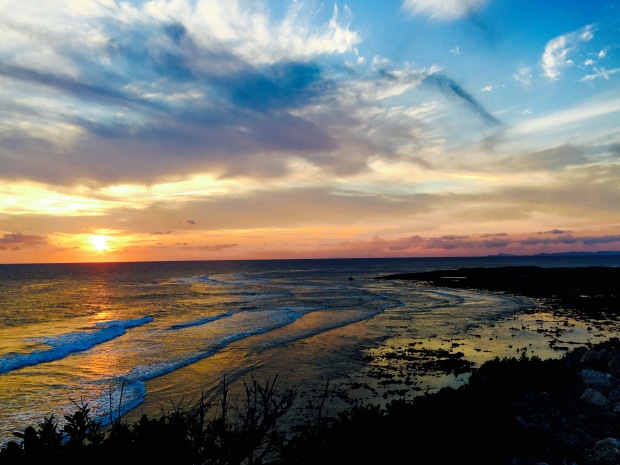I have no idea why people go to Okinawa World. An Okinawa themed park in Okinawa is ridiculous. My former classmate visited me late last year so I was tasked with finding some places to go that weren’t a total tourist trap. This can be hard to do without the right knowledge; Okinawa World, Pineapple Park, Murasaki Village and (I dare say it) the aquarium all score highly on Tripadvisor but offer very little insight into the history and culture of Okinawa. In other words, they’re really boring. So I took this challenge as an opportunity to finally visit Cape Kyan and the Gushikawa ruins. I figured that this would be a nice look into Okinawa’s past and that the bicycle ride down there would be fairly scenic. After some initial mumbling, I worked up the motivation to go out on a whole day of cycling around the south of Okinawa.
![IMG_0047[1]](https://samuchamploo.files.wordpress.com/2016/01/img_00471.jpg?w=620)
Stretches and stretches of tiny farms
I’m pretty creepy. I love looking at peoples houses and imagining what kind of person lives there. We cycled through small farms and residential areas to reach the ruins so my mumbling was replaced with genuine enjoyment as I got to look at all the different shaped houses. The Gushikawa ruins seems to be off the radar of most foreign tourists; as we cycled through the streets a local woman shouted out to us, “you’re in Kyan?!”. At first I mistook what she had said as, “do you have candy?”. We reached the castle late in the day and a few photographers had gathered to take photographs of the sunset.

Pretty colours
Not much of the castle remains but its defensive functions are still visible. The walls are characteristically thick and slanted like most castles of Okinawa, and are built to conform to the natural curve of the sea cliff. The castle was built relatively tall, most likely to provide surveillance for the surrounding area and sea. Although no buildings remain, there are Japanese signposts that explain various features of the castle. You can still see the entrance to a cave which was once connected the castle to the beach below. According to legend, this cave was used to deliver packages back and forth, and served as an escape route in times of emergency.
![IMG_0086[1]](https://samuchamploo.files.wordpress.com/2016/01/img_00861.jpg?w=620)
The remains of the outer wall and the sea cliffs
I wasn’t able to dig up much information on the history of the castle in English so I’ve had a go at translating some Japanese sources from Wikipedia and from photographs I took of the signs posted about. My head really hurts now. From what I’ve understood, it’s thought that the castle was built in the later half of the 12th century and remained in function until the mid 15th century. According to a document from 1743, the castle is where King Makanegoe, escaped to after coming under attack from King Manikutaru, the second son of King Ishikinawa. Gushikawa castle was given the same name of the King Makanegoe’s prior fortress, the Gushikawa Castle of Kume Island. The Gushikawa castle of Kume was overtaken by King Shinou and his army in the 16th century. Honestly, I have no idea who I’m talking about but I’m sure it’s all good to know.
![IMG_0082[1]](https://samuchamploo.files.wordpress.com/2016/01/img_00821.jpg?w=620)
You can still make out the general shape of parts of the castle
Gushikawa castle ruins is a bit off the beaten track but can easily be added on to a trip to the Peace Park and Himeyuri monument. I was able to do all three in one day on my bicycle but I would warn anyone attempting this that the area around the ruins is not well lit at night.
![IMG_0047[1]](https://samuchamploo.files.wordpress.com/2016/01/img_00471.jpg?w=620)

![IMG_0086[1]](https://samuchamploo.files.wordpress.com/2016/01/img_00861.jpg?w=620)
![IMG_0082[1]](https://samuchamploo.files.wordpress.com/2016/01/img_00821.jpg?w=620)

Reblogged this on Heritage of Japan.
LikeLike